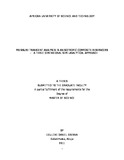| dc.contributor.author | Ezulike, Daniel Obinna | |
| dc.date.accessioned | 2016-09-08T15:44:17Z | |
| dc.date.available | 2016-09-08T15:44:17Z | |
| dc.date.issued | 2011-12-20 | |
| dc.identifier.uri | http://repository.aust.edu.ng/xmlui/handle/123456789/489 | |
| dc.identifier.uri | http://library.aust.edu.ng:8080/xmlui/handle/123456789/489 | |
| dc.description.abstract | A composite reservoir is one with multiple lateral compartments; each having distinct rock and fluid properties separated by geologic discontinuities. Geologically, composite reservoirs separated by leaky faults are rife but literature containing detailed three dimensional analyses of such anisotropic systems is few.
For the first time using transform methods, a general three dimensional point source semi-analytical solution for the drawdown response in composite clastic and naturally fractured systems separated by a leaky fault is developed. This solution is then converted to line source for horizontal and vertical wells and plane source for hydraulically fractured wells, while treating the leaky fault as a thin finite conductivity fracture separating two reservoirs with
different rock properties; arbitrary orientation is adopted for both horizontal and hydraulically fractured wells to obtain a general solution in an anisotropic system. Implementation of this solution is achieved using a simple computer program which can generate type curves in a
computationally cheap and effective manner.
Sensitivity analysis conducted on the pressure signature of horizontal, vertical and hydraulic fractured wells with respect to anisotropy, partial penetration, angle of orientation, well position, reservoir dimensions, dimensionless fault conductivity and mobility ratios in both
clastic and naturally fractured reservoir systems reveals that the drawdown response has a convoluted dependence on reservoir properties of both compartments and separating semi-permeable medium. Similar conclusion holds true for interference testing and for the first time, it is documented that the intersection time between the long-time approximation of both observer pressure drawdown and observer pressure derivative is unique; from which producer hydraulic diffusivity could be obtained.
Commercial simulator and three field data used to validate this semi-analytical model yields comparable results and direct synthesis of reservoir parameters from the resulting equation for various wells under different boundary conditions is examined. | en_US |
| dc.language.iso | en | en_US |
| dc.subject | Ezulike Daniel Obinna | en_US |
| dc.subject | Dr. Alpheus Igbokoyi | en_US |
| dc.subject | Pressure Transient Analysis | en_US |
| dc.subject | Anisotropic Composite Reservoirs | en_US |
| dc.subject | Reservoirs | en_US |
| dc.subject | Composite | en_US |
| dc.subject | Pressure | en_US |
| dc.subject | 2011 Petroleum Engineering Theses | en_US |
| dc.title | Pressure Transient Analysis in Anisotropic Composite Reservoirs – A Three Dimensional Semi-Analytical Approach | en_US |
| dc.type | Thesis | en_US |

